The best temperature for sleep. This topic might be up for debate in your household. For that reason, this blog post is here to explain the best temperature for sleep from a scientific point of view.
According to doctors and scientists alike, the recommended temperature for sleep is between 15-20 degrees celsius (60-67 degrees fahrenheit). Obviously, the perfect temperature can vary from person to person, so that debate with your partner is still valid.
Now that we’ve got the short answer out of the way, the rest of this post will go in depth about the perfect sleeping temperature. We’ll explore why the perfect temperature for sleeping is quite low, what this does to you while you sleep, and how to maintain this temperature.
Why is The Optimal Sleep Temperature Range so Low?
A “lower” environmental sleeping temperature is optimal because it helps our bodies to reduce our core body temperature. This is a physilogical response that prepares and makes us sleep better as shown in circadian rhythm research. We don’t know for sure yet why our bodies make a drop in its core temperature at night.
For some people (depending on how sensitive you are to temperature) the recommended temperature range might seem quite low. So, in order to understand why those clever scientists say these things, it may be helpful to look at the whole picture.
Let’s start with what our bodies are up to in the evening.
Our bodies actually experience a slight dip in core temperature in the evening. Our body does this at the same time as it’s releasing melatonin into the system.
For those who don’t know, melatonin is the chemical that our brain releases to make us sleepy. Our bodies are very intelligent and know what they need, so this drop in core temperature and release of melatonin is preparing us for a restful night of sleep.
The Circadian Rhythm
This whole process is all governed by something called the circadian rhythm. Without going into too much detail, the circadian rhythm is based on the cycle of light and dark created by the rising and setting sun.

This, with a whole host of other environmental factors, is what sets your ‘body clock’. So, when your body clock knows that it’s getting close to the time to get some rest, your core temperature starts to drop slightly.
Setting the thermostat in our bedrooms to this lower setting can help send a signal to our body that it’s time to go to sleep. This may help trigger all the other events that need to happen for healthy sleep.
Why is it Hard to Sleep When It’s Too Hot in The Bedroom?
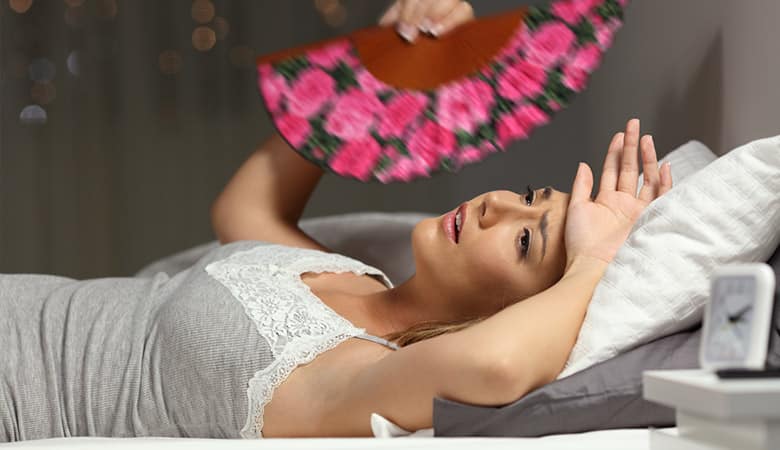
As anyone who has tried to sleep in a hot, stuffy bedroom will tell you, trying to sleep when it’s too hot is no fun. Especially considering the comfort and security that being covered by a blanket or duvet brings. This is near impossible in a hot and stuffy bedroom.
The obvious discomfort is the first thing we should consider. This causes us to toss and turn, sticking one foot out the bottom of the blanket. Then both feet. Then both arms. Maybe flipping the pillow over to have the cool side of the pillow on your face. This is not the best start to a good night’s sleep.
In a bedroom that is too hot, you might find yourself very tired and exhausted, but unable to sleep.
The second thing to consider is that while we go through different phases of sleep, our bodies actually stop regulating our body temperature. This means that, particularly during REM sleep, we won’t sweat or shiver in order to change our body temperature.
This can be a problem in a bedroom that is too hot. It will interrupt our sleep as we will most likely wake up and throw off the blanket or roll over. Interrupted sleep is not restorative sleep, and you will probably wake up feeling irritable and groggy.
While a warm bedroom will not have a direct effect on your health, it will have a direct effect on the quality of your sleep. And the quality of your sleep has a direct effect on your health. So make sure your bedroom is not too hot!
Your Bedroom Should Not be Too Cold Either
Similar to having a bedroom that’s too hot, having a bedroom that’s too cold is also disruptive to sleep.
If your bedroom is too cold, you might find yourself subconsciously piling blankets on top of yourself while you sleep. As we’ve already discussed, your body takes a break from regulating your temperature during certain phases of sleep.
So piling mountains of blankets on top of yourself while you sleep will most likely raise your body temperature. And because your body isn’t in the business of regulating your body temperature all night, you might wake up to adjust your body temperature manually. Things like throwing all those blankets onto the floor and taking your socks off.
This leads to interrupted sleep, which is not good for your sleep cycle.
In extreme cases, a cold bedroom can lead to more serious health concerns like hypothermia and frostbite, but I think we can assume that most people’s bedrooms are warmer than this. At least where the temperature can be controlled anyway.
How to Set Your Bedroom Temperature
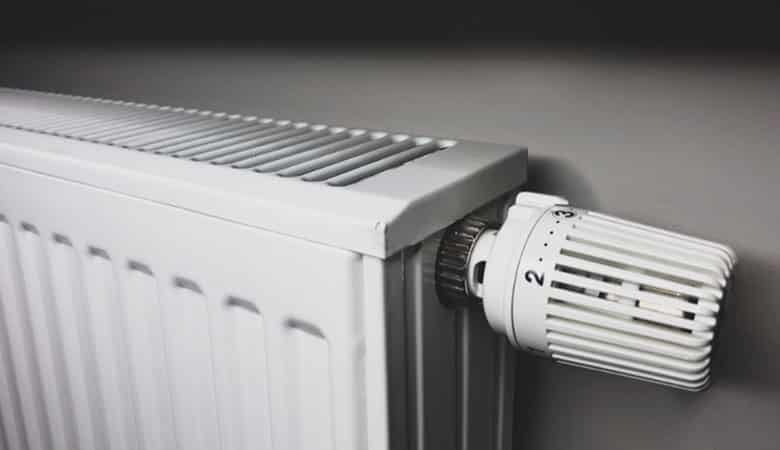
To achieve the optimal 15-20 degrees celsius (60-67 degrees fahrenheit) temperature in your bedroom, the most straight forward way in a modern home would be to:
- Adjust your radiators thermostat to achieve the correct temperature.
- Adjust your air conditionings thermostat (if you have this) to achieve the correct temperature.
Now, most homes today have a heat system that is runned on radiators. So keeping a room at the correct temperature in cold climates is fairly easy. However, most homes don’t have an air conditioning system. So for those who live in a hot climate, it’s much harder to keep a cool bedroom.
With that said, you can still do some things to sleep cooler. Here are some tips:
Tips For Those Without Air Conditioning Who Lives in a Hot Climate
Not all of us have the luxury of an AC thermostat to control the temperature in our bedrooms. For those folks, follow the tips in this section.
1. Use Thermo-Regulating Bedding Fabrics
A good place to start would be as close to your body as possible. Consider what type of clothing, if any, you wear to bed. As an extension of this, consider the type of bed linen you use. They are not all made the same.
An important consideration is the materials that these things are made of. There are plenty of ‘thermo-regulating’ products on the sleep market. And this can make your life quite complicated. Afterall, what is the right choice?
While a breakdown of all the different materials and products you can use in your bedroom is beyond the scope of this post, there is a rule of thumb that can be quite effective when things start to get confusing.
Here it is:
Natural materials seem to outperform synthetic ones. All the ‘temperature control technology’ that brands use nowadays are trying to do the same thing. They are trying to mimic the qualities found in naturally occurring materials. So an easy way to avoid the confusion is simply to choose natural materials in the first place.
Another thing to consider is what type of material your pillow(s) and mattress(es) are made of. If these are made of foam, like memory foam or latex etc, they could retain a lot of heat as these materials are known to do so. This is obviously problematic if you want to sleep cool.
Now, my suggestion is not to ban foam mattresses and pillows from your home. They do have other properites that are amazing for your sleep, such as great contouring, cushioning and stability. But, what I do suggest is looking into getting foam pillows and a mattresses that has some sort of built in cooling system. Many great brands offer this.
Here’s an article where I list the 10 coolest memory foam mattresses on the market in 2021.
2. Increase Ventilation
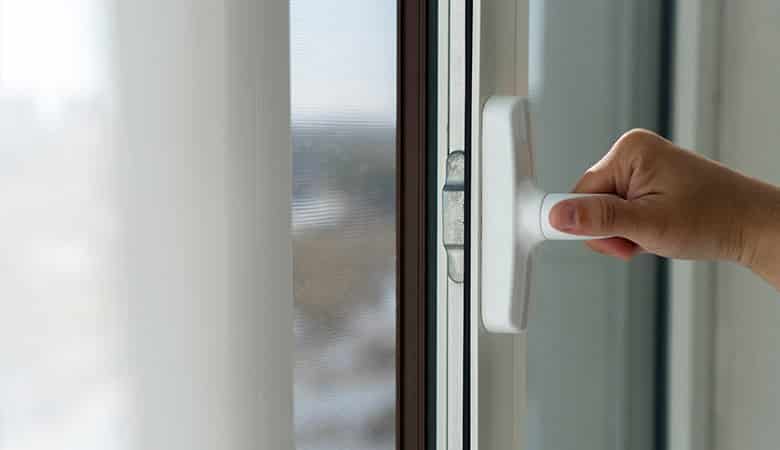
This one depends on your climate and what you are trying to achieve. If you live in the tropics, ventilation is an important thing to keep in mind. We all know how much relief a cool breeze can bring on a hot day.
This is because the heat that builds up around your body is whisked away by the moving air. So even if the breeze is not significantly colder than the ambient temperature, a flow of air can have a significant effect on our comfort levels.
To achieve this, simply open a window. For better results, if possible, open two windows on opposite sides of the room. This encourages cross-ventilation and can have a significant effect on the comfort of the room’s occupants.
Another this to consider, admittedly more expensive, would be to get some sort of air conditioning system. Either you go big and get a full blown air conditioning ventilation system, or you go small and buy a portable air conditioner. The latter typically sell for around $250-400 depending on brand and functions.
For me, getting a great nights sleep during the hottest of nights is well worth the money invested in a portable air conditioner. If you are interested in getting one you compare specs and prices over at Amazone here.
3. Sleep Low
Consider sleeping on a lower level of your house during the hottest months. As hot air rises, sleeping low takes advantage of the colder air present closer to the ground.
In some cultures in the tropics, people abandon the bed all together and sleep directly on the ground. This takes advantage of the stable, and often colder, temperature of the ground as well as the higher rate of air circulation.
Tips For Those Who Lives in a Cold Climate
For those in less peachy climates, you’re trying to achieve the opposite. You’re trying to warm things up and keep the cold out.
Since most homes placed in cold climates have radiators it’s more a question of keeping the heating bill low. And here are some tips to do so:
1. Decrease Ventilation
In this situation, ventilation is the enemy. Excessive ventilation is referred to as a draft in this context. And nobody wants a cold draft when you’re trying to keep warm.
Make sure all your doors and windows are correctly weather sealed to stop those sneaky drafts from messing up your perfect sleeping environment.
2. Cover Windows
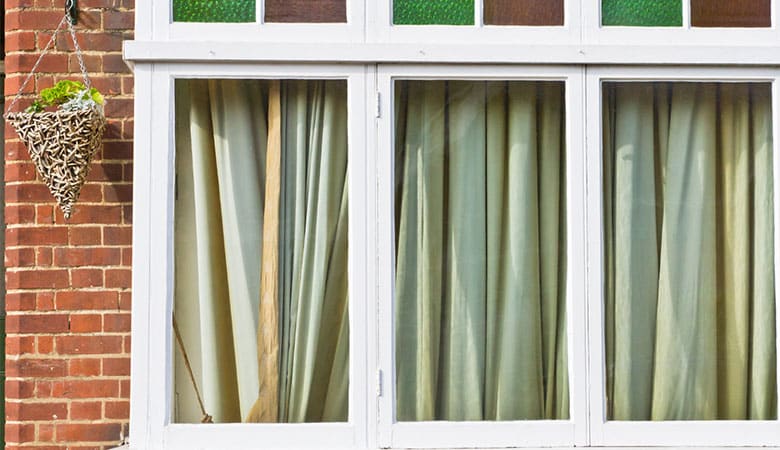
Window coverings are an often overlooked and very effective method of keeping inside temperatures stable. Make sure the covering covers as much of the window as possible.
This is because windows are a weak point in the envelope of a building. Meaning that your windows, even if they are closed, are where you will lose much of the heat out of your bedroom. This will also help reduce your heat bill, which is great.
A great item that can help cover your windows, while also providing you with a dark bedroom (which is another factor that leads to better sleep), are blackout curtains. I’ve written a lot more about blackout curtains in this post if you are interested in learning more.
We Are All Different And Require Different Temperatures
This shouldn’t come as a shock to you, but we’re not all the same. And this statement is also true for our core body temperatures. According to those clever scientists I mentioned earlier, females can run between 3-10 percent colder than males.
So if you and your partner of the opposite gender can’t agree on the optimum temperature of your bedroom, you can blame science.
Gender is not the only thing that can have an effect on different body temperatures. Age and health also factor into our core body temperatures.
It’s important to note that the best temperature for a sleeping infant is a little bit warmer than for adults. This is because, as the infant is still developing, their body can’t regulate their body temperature as effectively as a fully developed, full grown adult.
It’s recommended that you check with your paediatrician for the details about the correct temperature for your sleeping infant. This is important because a sleeping environment that is too hot could lead to sudden infant death syndrome (SIDS).
What is Good For Your Bedroom is Not Good For The Rest of Your Home
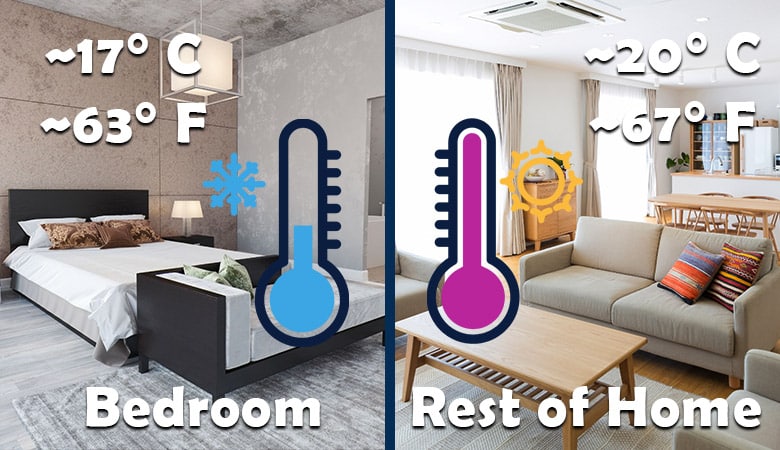
As you may have noticed, the optimum temperature for your bedroom is a bit colder than is generally considered comfortable. Room temperature is generally considered to be about 20 degrees celsius (67 degrees fahrenheit).
This still might be a bit cold for some of us. But the good news is that if you’re cold, you can grab an extra blanket. If you’re too hot in your bedroom, it can be quite a bit more difficult to lower the temperature of the room, and therefore, your core temperature.
More good news is that if you are heating your home to more than 22 degrees (71.6 degrees fahrenheit), the cost on your utility bill will be quite a lot higher. So if you can manage to not heat your home any higher than 22 degrees celsius, you will sleep better and save money. And that’s something we can get behind.
The Idea Behind Sleep Hygiene
Sleep hygiene is not a term that you hear very often. And it might not mean what you think. But keeping your bedroom at the correct temperature is a vital part in having good sleep hygiene.
Sleep hygiene refers to the practice and routine of making sure you create the prime conditions for proper sleep. Prime conditions both in your body and in your environment.
As we now know the optimum temperature for good sleep, let’s look at a few other things that can contribute to good sleep hygiene.
Sleep Hygiene Tips For Lowering Your Core Temperature
There are some tricks you can use to trigger your body into lowering its temperature a few hours before you go to sleep. Because, as we now know, this is a natural process that your body goes through when it’s winding down to rest.
1. Take a Hot Bath or Shower

Taking a hot bath or shower can help to trigger this natural process. After the hot bath or shower, your body will naturally start to cool down. If you time it right, your body could naturally cool itself all the way down to the slightly lower temperature that your core needs to be at for a proper sleep.
Our body temperatures will slowly continue to drop until about 5 a.m. Before it starts to rise again just before you wake up, refreshed and ready for the day ahead.
Unfortunately, body temperature is not the only factor that plays a part in a good night’s sleep. Other sleep hygiene best practices can also help you get the proper rest you need.
2. Avoid Caffeine and Alcohol For a Few Hours Before Bed
The alcohol point might come as a surprise to some people. As I’m sure a lot of people have had the experience of falling asleep very quickly after drinking alcohol.
While falling asleep may not be the problem, staying asleep and having a night of quality sleep is the problem. You will probably wake up feeling groggy and not very well rested. This is the effect of the alcohol you had before you went to sleep.
3. Go to Sleep at Around The Same Time Each Night
Another thing that can contribute to good sleep hygiene is going to sleep around the same time every night. This can actually train your body to adjust your circadian rhythm to start winding down at about the same time every night.
As mentioned earlier, the circadian rhythm is the thing that signals your body to start dropping it’s core temperature before you go to sleep. So keeping a predictable schedule for your body to keep up with will make falling asleep easier. And hopefully also lead to better quality sleep and higher functioning humans.
4. Keep Your Room Dark
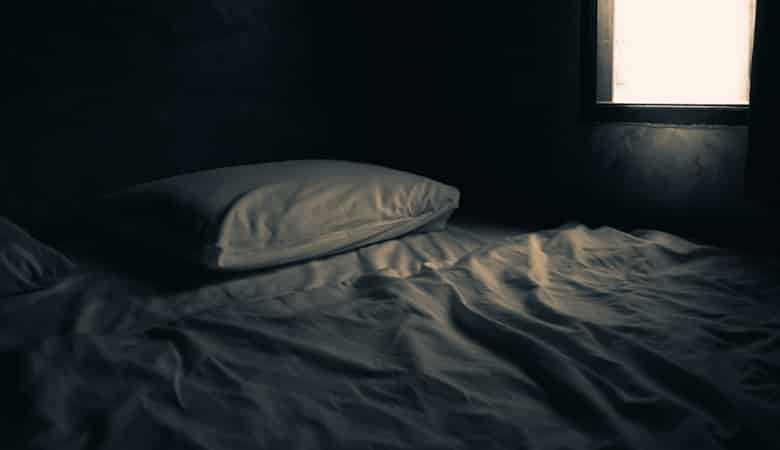
Keeping your room dark is another thing that can help your sleep hygiene. Heavy curtains/Blackout curtains that block outside light from entering the windows while you sleep is the obvious one. Nobody likes a streetlight shining into your bedroom while you’re trying to sleep.
If you’re interested in blackout curtains then check out our buyers guide here, where we list our favourites, including pros and cons.
Some less obvious or considered sources of light that could interrupt your sleep are the lights shining from all the electronics that we surround ourselves with.
From alarm clocks with bright number displays or maybe the TV in your bedroom that has a little standby light always shining, these are things to take note of and eliminate from your sleeping space if you are battling to get a good night’s rest.
Talking about electronics, too much screen time before bed can wreak havoc on your sleep cycle and your circadian rhythm.
It’s best to abstain from screens at least an hour before bed. If you need some entertainment, read a book. Or talk to your family. I think we could all do with less screen time in our lives.
Wrapping it up
In conclusion, the best temperature for a good night of sleep is a little below room temperature at around 15-20 degrees celsius (60-67 degrees fahrenheit).
This matches the drop in core body temperature that we all experience in the evening. Matching this natural process can have a significant impact on falling asleep easily and staying asleep all night for a comfortable night’s sleep.
Unfortunately, there’s more to getting a good night’s sleep than just setting your thermostat to the right temperature. Following good sleep hygiene is important in maintaining a consistent circadian rhythm which has a big contribution to good quality rest.
While science can tell us what the optimum temperature in your bedroom for sleep is, we are all different. Factors like age, health, and gender all play a part in what our core temperature is. So, while science can give us the average numbers, your own experience may be the biggest factor in what temperature you set your thermostat to.
Be especially careful with the thermostat in your infant’s bedroom. As an infant that is too hot while sleeping can have devastating effects on the health of your infant.
